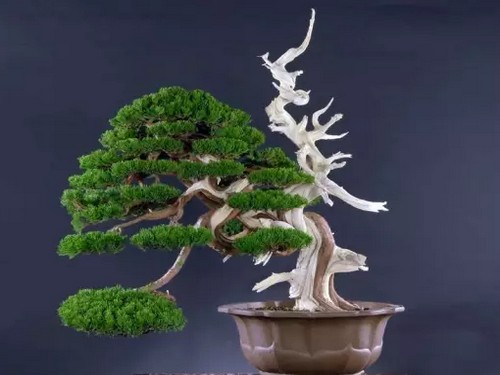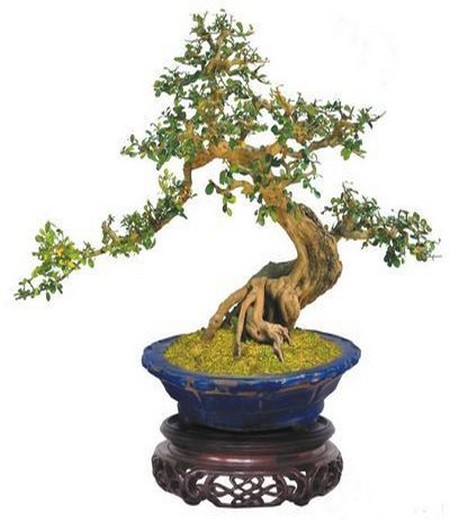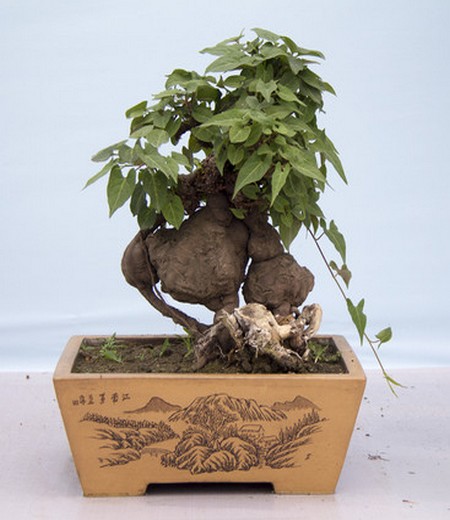The method of making real cypress bonsai
Real cypress bonsai has always been famous in bonsai circles at home and abroad for its old stem, tight leaves and graceful posture, especially in Japanese bonsai exhibitions, which are made of century-old cypress, with white bones and red skin, such as swimming dragons, vigorous and simple, with Xianjia style, which can be called the top grade of bonsai. Taiwan's potted cypress, in addition to Japanese varieties, Tian Pei is also suitable to be cultivated into a potted plant. It is generally known as Taiwan's true cypress, with a lump-like structure, emerald-green color, and rich xylem oil. Red lattice is comparable to the Japanese mountain-picked Yukawa cypress, which is very strong and durable, and is an excellent variety after.

[material selection and cultivation]
Artificial propagation: Sabina vulgaris is usually propagated by cutting or striping. The best cuttings are annual twigs, the ear length is 10-15 cm, cut off the branchlets below the middle, and the depth is 1B2; the seedling bed is mixed with rotten leaf soil, which is suitable for fertile and loose, and the drainage is good. Pour water after insertion, set up a shed for shade at any time, and take root after 2-3 months. Separate planting and transplanting were carried out in the spring of the following year to cultivate large seedlings. The true cypress often grows on the creeping ground, and the adventitious roots occur, so it can also be propagated by striping method. Grafting propagation with Platycladus orientalis or Platycladus orientalis seedlings as rootstock is also easy to survive.
[on the basin]
Selection basin: Zhenbai should use purple sand pottery basin, large bonsai can also use stone chiseling basin. The shape of the basin is suitable for medium-deep rectangle, oval, square, circle, hexagonal, etc.; cliff type can use deep thousand-cylinder basin.
Use soil: real cypress should use fertile and loose neutral soil or calcareous soil. Potted humus soil is often mixed with charcoal shavings or sand.
Planting: it should be carried out from April to May in spring, or in autumn. When planting, you should pay attention to using tiles to cushion the hole in the basin to facilitate water penetration. After planting in the pot, the water should be watered enough for the first time, and then watered again after a little dry.
[pose]
Technical processing: the modeling processing of cypress is mainly climbing and pruning as a supplement. Generally speaking, it is more convenient to climb with wire, stretch and bend freely, the lines are smooth, and the branches can be twisted to show the elegance of the cypress. When climbing, it is important to tie up the shape of the main branches, and the twigs can be climbed or trimmed.
Some branches of the real cypress can be made into withered branches, that is, the so-called "sherry stem", imitating the phenomenon that some branches are split and the bark peeled off due to long-term wind, rain and lightning attacks on trees in nature, thus producing a quaint and strange effect. When making, you can first select some branches (often use unwanted branches), cut off the twigs and leaves, peel off the bark from the base, cut it with a knife or peel it with your fingers. The tip of the branch must be cut into a natural broken shape so as not to show artificial traces. Finally, the peeled branches are coated with lime-sulfur mixture to prevent decay. The location of "Shuligan" is very important, it plays a role in adjusting the density and increasing the contrast of the whole cypress shape, so it should be carefully considered. The "sherry stem" can be at the top of the tree or in the middle of the branch, depending on the modeling needs.
Tree shape: the ancient cypress growing in nature is often Qiu qu, and the tree shape of real cypress can also be made into qu dry type, followed by cliff type, oblique dry type and horizontal dry type. The trunk of the curved trunk must be tortuous and changeable, and special attention should be paid to the change in the direction and degree of bending. Cliff type, oblique dry type and horizontal dry type trunk should not be too straight, but should be somewhat curved.
The branches and leaves of Sabina vulgaris should be clustered and droop properly. In addition, some of the branches of true cypress can also be made into "Shuli stem".
Time: 2019-05-26 Click:
- Prev

The process of making boxwood bonsai
The branches of Populus tomentosa are gray and bright, the leaves are as small as Douban, the texture is thick and bright, the four seasons are green, and can be watched all the year round. Cut into clouds, thin as cut, or embellished with mountains and rocks, it is more natural and wonderful. Poplar bonsai trees are graceful, with leaves as small as beans, thick and shiny, evergreen all the year round, and can be watched all the year round. Yang Pai Huang Yang bonsai
- Next

Production method of Polygonum multiflorum bonsai
Polygonum multiflorum can be planted in four seasons and can live in four seasons. Shade-resistant, water-resistant, dry-resistant, sun-resistant, a few books are resistant to everything. I have planted cactus before, but Polygonum multiflorum has not yet been planted dead. I now share the method of making potted landscape of Polygonum multiflorum for reference. 1. Choose soil and mix it with soft and breathable soil, preferably with river sand at 1:1.
Related
- Fuxing push coffee new agricultural production and marketing class: lack of small-scale processing plants
- Jujube rice field leisure farm deep ploughing Yilan for five years to create a space for organic food and play
- Nongyu Farm-A trial of organic papaya for brave women with advanced technology
- Four points for attention in the prevention and control of diseases and insect pests of edible fungi
- How to add nutrient solution to Edible Fungi
- Is there any good way to control edible fungus mites?
- Open Inoculation Technology of Edible Fungi
- Is there any clever way to use fertilizer for edible fungus in winter?
- What agents are used to kill the pathogens of edible fungi in the mushroom shed?
- Rapid drying of Edible Fungi

